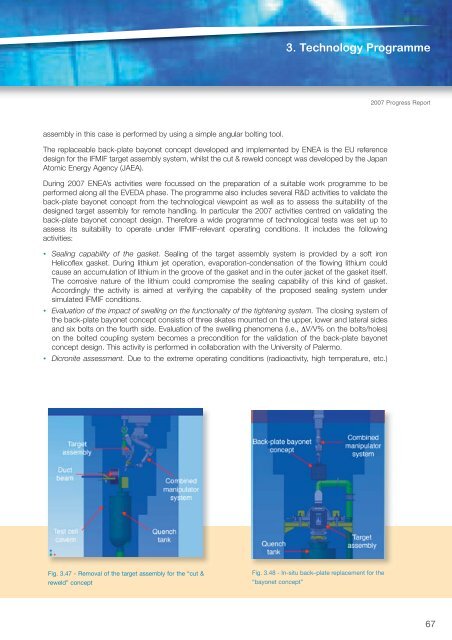Fusion Programme - ENEA - Fusione
Fusion Programme - ENEA - Fusione
Fusion Programme - ENEA - Fusione
- No tags were found...
Create successful ePaper yourself
Turn your PDF publications into a flip-book with our unique Google optimized e-Paper software.
3. Technology <strong>Programme</strong>2007 Progress Reportassembly in this case is performed by using a simple angular bolting tool.The replaceable back-plate bayonet concept developed and implemented by <strong>ENEA</strong> is the EU referencedesign for the IFMIF target assembly system, whilst the cut & reweld concept was developed by the JapanAtomic Energy Agency (JAEA).During 2007 <strong>ENEA</strong>’s activities were focussed on the preparation of a suitable work programme to beperformed along all the EVEDA phase. The programme also includes several R&D activities to validate theback-plate bayonet concept from the technological viewpoint as well as to assess the suitability of thedesigned target assembly for remote handling. In particular the 2007 activities centred on validating theback-plate bayonet concept design. Therefore a wide programme of technological tests was set up toassess its suitability to operate under IFMIF-relevant operating conditions. It includes the followingactivities:• Sealing capability of the gasket. Sealing of the target assembly system is provided by a soft ironHelicoflex gasket. During lithium jet operation, evaporation-condensation of the flowing lithium couldcause an accumulation of lithium in the groove of the gasket and in the outer jacket of the gasket itself.The corrosive nature of the lithium could compromise the sealing capability of this kind of gasket.Accordingly the activity is aimed at verifying the capability of the proposed sealing system undersimulated IFMIF conditions.• Evaluation of the impact of swelling on the functionality of the tightening system. The closing system ofthe back-plate bayonet concept consists of three skates mounted on the upper, lower and lateral sidesand six bolts on the fourth side. Evaluation of the swelling phenomena (i.e., ΔV/V% on the bolts/holes)on the bolted coupling system becomes a precondition for the validation of the back-plate bayonetconcept design. This activity is performed in collaboration with the University of Palermo.• Dicronite assessment. Due to the extreme operating conditions (radioactivity, high temperature, etc.)Fig. 3.47 - Removal of the target assembly for the “cut &reweld” conceptFig. 3.48 - In-situ back–plate replacement for the“bayonet concept”67













